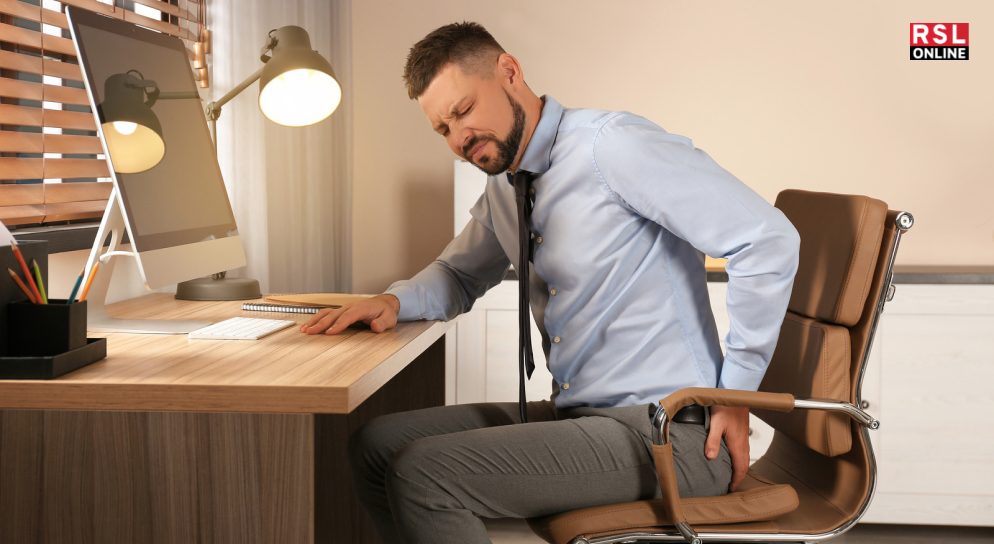It is time for you to say goodbye to sciatic nerve pain in just 10 minutes with this natural method!
Yes, you read that right!
If you have been feeling this unbearable pain up and down your leg, it is the sciatica nerve pain. But trust me, it is not impossible to get rid of.
Five years ago, my father was going through this excruciating sciatica nerve pin. And when we took him to the doctor (as the pain stopped him from sleeping at night), there were a few things that the doctor told us.
In this article, I am going to jot down everything that helped my father treat his sciatica nerve pain in just 10 minutes! So, without further ado, let us get started…
Understanding Sciatica Nerve Pain

Before you plan to say goodbye to your sciatica nerve pain in less time, ot is important that you understand what it is in the first place!
A form of nerve pain known as sciatica is brought on by irritation or damage to the sciatic nerve. In addition to discomfort, you might feel numbness or tingling in your back or butt, which could radiate down your leg.
More severe symptoms are also possible. The sciatic nerve is the thickest and longest nerve in your body. The sciatica nerve can be up to two centimeters wide.
Despite its name, it’s not a single nerve. It is a collection of nerves that emerges from your spinal cord and is derived from the roots of five nerves.
You have two sciatic nerves on each side of your body. Each sciatic nerve travels through your hip and buttocks on one side. On either side of your body, they descend the leg until they are just below your knee.
Once there, they split into other nerves that connect to regions farther down, like your lower leg, foot, and toes. If you have sciatica, you may experience mild to severe pain wherever certain nerves connect to the sciatic nerve.
Your lower back, buttocks, hips, or legs may be affected. Certain symptoms may extend as far down as your feet and toes, depending on the nerve or nerves affected.
What Causes Sciatica Nerve Pain?
Any disorder that affects the sciatic nerve might induce sciatica. Conditions that might have affected any one of the 5 spinal nerves that bundle to make the sciatic nerve can potentially cause it. Herniated disks are among the conditions that can result in sciatica.
Some other causes of sciatica nerve pain can include:
- Degenerative disk disease.
- Spinal stenosis.
- Foraminal stenosis.
- Spondylolisthesis.
- Osteoarthritis.
- Wounds.
- Growths such as tumors or cysts.
- Syndrome of conus medullas.
- Syndrome of cauda equina.
Get Rid of It: Say Goodbye To Sciatic Nerve Pain In Just 10 Minutes With This Natural Method!

According to Harvard Medical School, about 90% of sciatica sufferers will recover without surgery, regardless of the underlying cause. And guess what? The majority can do so in a matter of weeks.
You can begin at-home treatment for your sciatica. Additionally, if you know that your sciatica is due to an injury or pregnancy, home treatment can be all you need. You can take measures to alleviate your sciatica pain at home, even if unsure of the cause.
There are numerous short-term, temporary sciatica treatment methods. To see long-term effects, however, you must perform them numerous times over a few weeks.
Because of this, sciatica doctors frequently offer comprehensive treatment strategies that combine many therapy modalities.
These are the best methods for rapidly alleviating sciatica discomfort:
Hot and Cold Compress
Firstly, heat and cold packs can help reduce sciatica pain and increase the range of motion. Try applying cold packs to your lower back when sciatica pain initially begins.
Pain may be alleviated by the cold’s ability to diminish sciatic nerve inflammation. Furthermore, always cover the ice pack with a cloth or towel while using ice to prevent frostbite.
After applying it for 15 to 20 minutes, rest for at least 15 to 20 minutes before applying it again.
A cycle of “on-off-on-off-on,” which lasts for roughly 75 to 100 minutes, is an excellent strategy. After that, stop and observe your feelings.
Another possibility is ice massage. To test this, try freezing water in a paper cup and removing the top half.
Cover a six-inch-wide region of your lower back with the ice and gently massage it in a circular motion. Avoid the bony portion of your spine and keep the ice flowing to avoid frostbite.
Wait at least an hour before repeating the message, and keep it to no more than ten minutes. You can try doing light stretches between ice applications, but it’s best to wait around half an hour to allow the region to warm up. Try to use ice three to five times a day for pain relief.
You can begin applying heat as soon as the discomfort starts to subside. Heat boosts blood flow to the area and aids muscle relaxation and healing. Stretching may become easier as a result, further reducing pain.
Soak in a warm bath or apply a heating pad or towel-wrapped hot water bottle to your lower back. It could be necessary to see a doctor for guidance if the discomfort hasn’t subsided after a week.
Keep Moving
Secondly, the most crucial thing you can do to reduce your pain is most likely to move. Many sciatica sufferers believe resting in bed or relaxing in an easy chair will aid in their recovery. No, it doesn’t!
Resting is acceptable for the first few days after sciatica pain begins, but after that, staying in bed tends to exacerbate the condition rather than alleviate it. Relocating relieves your pain in several ways:
- Your muscles become stronger as a result, supporting your spine.
- It can increase the range of motion and flexibility.
- This accelerates healing by increasing blood flow to all body parts, including wounded ones.
- It lessens the sense of pain.
Move as much as you can as quickly as you can if you have sciatica. It’s best to consult a doctor and discuss the situation if movement exacerbates the discomfort.
To reduce the chance that your sciatica will recur, continue to move once it has been managed.
Long sitting durations are bad for everyone. Sitting for extended periods can raise your chance of developing sciatica and exacerbate existing symptoms.
Exercise
Thirdly, the best treatment for sciatica is to reduce pressure on the sciatic nerve. Sciatica can usually only be permanently cured with specific forms of surgery.
However, not everyone can have surgery, and more conservative treatment choices can often provide quick relief from sciatica.
This is frequently easier said than done, though, particularly if you don’t know where the nerve compression is and what exercises may likely relieve it.
1. Cat Cow Pose
Place your hands underneath your shoulders and your knees below your hips. After that, begin on all fours. Round your back with your elbows bent slightly and gaze at the floor. Maintain this posture for a few seconds.
Next, arch your back downward and look up at the ceiling while slowly and gracefully pushing your belly button toward the floor. Continue doing this for eight minutes or until your sciatic area feels better.
2. Quadruped Arm and Leg Lift
For this pose, you should begin on all fours. Place your knees below your hips and your hands right under your shoulders. Maintaining your hips level, slowly extend your left leg behind you to its maximum length while placing your toes on the ground.
Gently lift your outstretched leg off the floor and extend your right arm in front of you. Aim to maintain a level spine without any rounding or arching.
After six seconds of holding, drop your arm and leg to the ground and take 10 seconds to relax. For immediate sciatica treatment, repeat a few times on each side.
3. Bridge Technique
With your knees bent and hip-width apart, lie on your back. Keep your spine neutral, and place your hands on your tummy. Lift your pelvis slowly off the floor until your body forms a diagonal line from your head to your knees, using your stomach muscles for support.
After a few seconds of holding, carefully lower your pelvis to the floor. In addition to strengthening your glutes, this exercise will quickly relieve sciatica.
4. Pelvic Tilts
With your knees bent and your feet flat, lie on your back on your bed, table, or the floor. Press your back on the ground.
As you bring your navel into your spine, visualize reversing the lower back’s natural curve into the floor. For ten seconds, maintain this posture without allowing it to rise off the ground. After ten repetitions of this treatment, rest.
5. Sciatic Flossing
Finally, you must try to do a sciatica flossing. Let me tell you how you should do it!
Until you feel a slight tightness in the back of your leg and possibly your lower back, slowly straighten the affected leg while sitting at the edge of the chair. Keep your body slouched, and use your foot or ankle to nod your head up and down.
Although it requires coordination, you can perform this quite effectively with practice. Avoid trying to straighten the afflicted leg to the point of tightness. Because it exacerbates symptoms, caution is required. After 20 repetitions of this coordinated action, take a break.
The BEST Way to Treat Sciatica Nerve Pain!
In case you wanted to say goodbye to sciatic nerve pain in just 10 minutes, with this natural method you can do that right!
Finding and treating the underlying cause of sciatica pain is the best course of action. Naturally, this takes longer than eight minutes, but compared to the available quick solutions, it is more likely to produce long-lasting results.
With sciatica, each person may have distinct symptoms and pain thresholds. No two persons have the same kind of pain, the same level of intensity, and different causes of pain.
While some people experience comfort from self-care home remedies in a matter of days, others require more time to see results.
See your doctor if self-care measures like stretching, applying heat and ice, and using over-the-counter drugs don’t appear to be helping your discomfort.
Read Also:




























